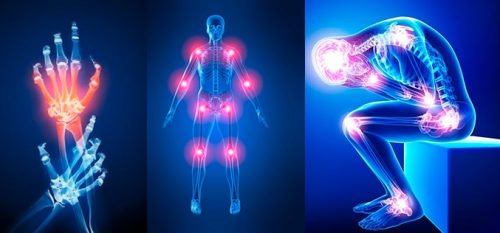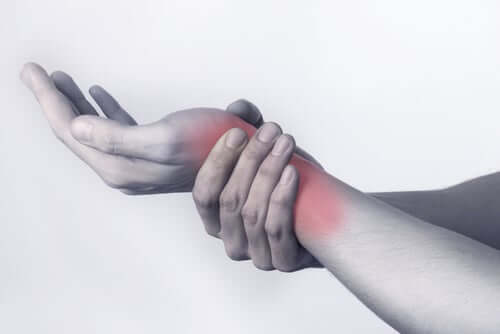Causes of Joint Pain - Seven Possible Reasons


Reviewed and approved by the doctor Maricela Jiménez López
Joints are the point of union where the ends of the bones sort of rest to allow mobility and the cause for joint pain are many and varied.
Because joints are constantly under pressure, either by the rubbing that happens when you move or from supporting the weight of your body. Such is the case with knees and ankles and pain is usually a reflection of various complications.
Would you like to know the possible reasons why your joints might hurt?
So, the first thing you should know is there’s not a single reason for joint pain. However, there are several triggers.
In today’s article, we’ll tell you the most common causes of joint pain.
1. Repetitive movements

It may be that the causes of joint pain we mentioned above have nothing to do with you.
In that case, you should pay attention to find out if you’re performing repetitive movements in the area that’s now hurting or causing discomfort.
This is because we get so used to certain activities that we don’t even notice them and we seldom associate them with the health problems we have.
Repetitive movements can cause:
- Tendonitis is an inflammation of the tendon that connects the muscle with the bone. Thus, it doesn’t allow the joint to move as it should, according to this study carried out by Dalhousie University in Canada.
- Inflammed ligaments. These are part of the musculoskeletal system and their damage can compromise the movement of the joint.
If you’ve noticed that your joints hurt, we recommend that you go to your doctor to determine the reason and find a solution.
Perhaps, in the beginning, you’ll think that it won’t get worse but, over time, the pain will begin to affect your daily life.
2. Infections

This is one of the most common reasons for joint pain.
If you had a wound you didn’t clean properly, bacteria such as Staphylococcus aureus or Streptococcus may have produced osteomyelitis, as per this report obtained by The United States National Library of Medicine.
At first, you’ll feel pain and then the fever and chills typical of infection will appear. Note that medical intervention is necessary here. And your doctor will most likely prescribe intravenous antibiotics to counteract the bacteria.
It’s important to seek specialized help. If you don’t, then the infection will worsen and spread to the rest of your body causing sepsis, which is often fatal.
The good news is medical treatment is very simple, easy to follow, and cheap if you seek it in time.
Check out: The Symptoms of Rheumatoid Arthritis
3. Gout
Certain types of foods, such as red meat, shellfish, alcoholic or sugary drinks, can increase the production of uric acid in the body and accumulate urate crystals in the joints. This produces a discomfort known as Gout, according to this report from the Mayo Clinic.
Gout manifests in joint pain, redness, and inflammation and, if it’s very advanced, it can even hinder your mobility.
To avoid this problem, you must eat healthily and control your intake of fats, fish, and meat. You must also limit alcohol or avoid it entirely, maintain your optimal weight, and lead a healthy lifestyle overall.
Discover: Lyme Disease Symptoms You Need to Know
4. Lyme Disease
Lyme disease is another reason why you may have joint pain. It’s an infectious disease caused by the bite of an infected tick, as stated in this study carried out by the Hospital San Pedro-Centro de Investigación Biomédica de La Rioja in Spain.
This disease occurs when a tick sucks blood from a person and passes on a bacterium.
Symptoms include:
- Rash
- Fever
- Body aches
- Neck stiffness
- Tiredness or fatigue
If you think you may have this problem, then you need to go to the doctor in order to get a correct diagnosis.
Fortunately, antibiotic treatment is enough both to eliminate the infection and to prevent it from spreading to other joints and internal organs.
5. Lupus
Lupus is classified as an autoimmune disease and is one of the causes of joint pain.
This is a typical consequence of this disease because the immune system attacks different parts of the body as if they were external harmful agents.
To put it succinctly, this means that lupus can affect the joints, skin, blood, kidneys, heart, lungs and other organs.
People with this disease may suffer from:
- Rashes
- Hair loss
- Mouth sores
- Breathing problems
- Memory problems
There is no known cure for this disease. However, according to The Lupus Foundation of America, between 80% and 90% of those affected by it can have a normal life.
6. Gonorrhea
This is a sexually transmitted disease that affects the genitals, causes joint pain, and what’s known as gonococcal arthritis (as per this study by Centro de Investigacion sobre Enfermedades Infecciosas del Instituto Nacional de Salud Publica de Mexico).
Gonorrhea symptoms may take time to appear and vary between men and women. So, if you suffer from this disease and your joints hurt you should talk to a specialist.
If you are not sure of having it and you have the following symptoms:
- Fever
- Lower abdominal and joint pain
- Pain in the hands and wrists due to swelling
- Burning when urinating
- Serous secretions from the penis or vagina
Only a specialist can diagnose gonorrhea, through a blood test or a urinary secretion test. Thus, there’ll be complications such as pelvic pain and infertility if not treated in time, according to this report by the Centers for Disease Control and Prevention in the USA.
Finally, the only possible treatment for gonorrhea is through antibiotics.
7. Rheumatoid Arthritis
Rheumatoid arthritis is another possible cause of joint pain, as pointed out by this study conducted by the Pontifical Catholic University of Chile.
This is another one of the causes of joint pain. In fact, this type of arthritis is an autoimmune disease. In addition, it’s primarily characterized by swelling and morning stiffness in the joints.
Besides, other symptoms may include fever, fatigue and weight loss.
Rheumatoid arthritis usually begins mildly. However, over time, it can lead to deformities in the hands.
Furthermore, treatment lasts a long time and involves:
- Physiotherapy
- Medication
- Exercise
- Surgery
Finally, you must treat joint pain from the beginning so that its effects are as uncomfortable as possible.
All cited sources were thoroughly reviewed by our team to ensure their quality, reliability, currency, and validity. The bibliography of this article was considered reliable and of academic or scientific accuracy.
- Laslett, M. (2008). Evidence-Based Diagnosis and Treatment of the Painful Sacroiliac Joint. Journal of Manual & Manipulative Therapy. https://doi.org/10.1179/jmt.2008.16.3.142
- Enseki, K., Harris-Hayes, M., White, D. M., Cibulka, M. T., Woehrle, J., Fagerson, T. L., … Torburn, L. (2014). Nonarthritic Hip Joint Pain. Journal of Orthopaedic & Sports Physical Therapy. https://doi.org/10.2519/jospt.2014.0302
- Kidd, B. L. (2006). Osteoarthritis and joint pain. Pain. https://doi.org/10.1016/j.pain.2006.04.009
- Soler-González, J., & Torrecillas, D. R. (2007). Gonorrea. FMC Formacion Medica Continuada En Atencion Primaria. https://doi.org/10.1016/S1134-2072(07)71537-2
This text is provided for informational purposes only and does not replace consultation with a professional. If in doubt, consult your specialist.








